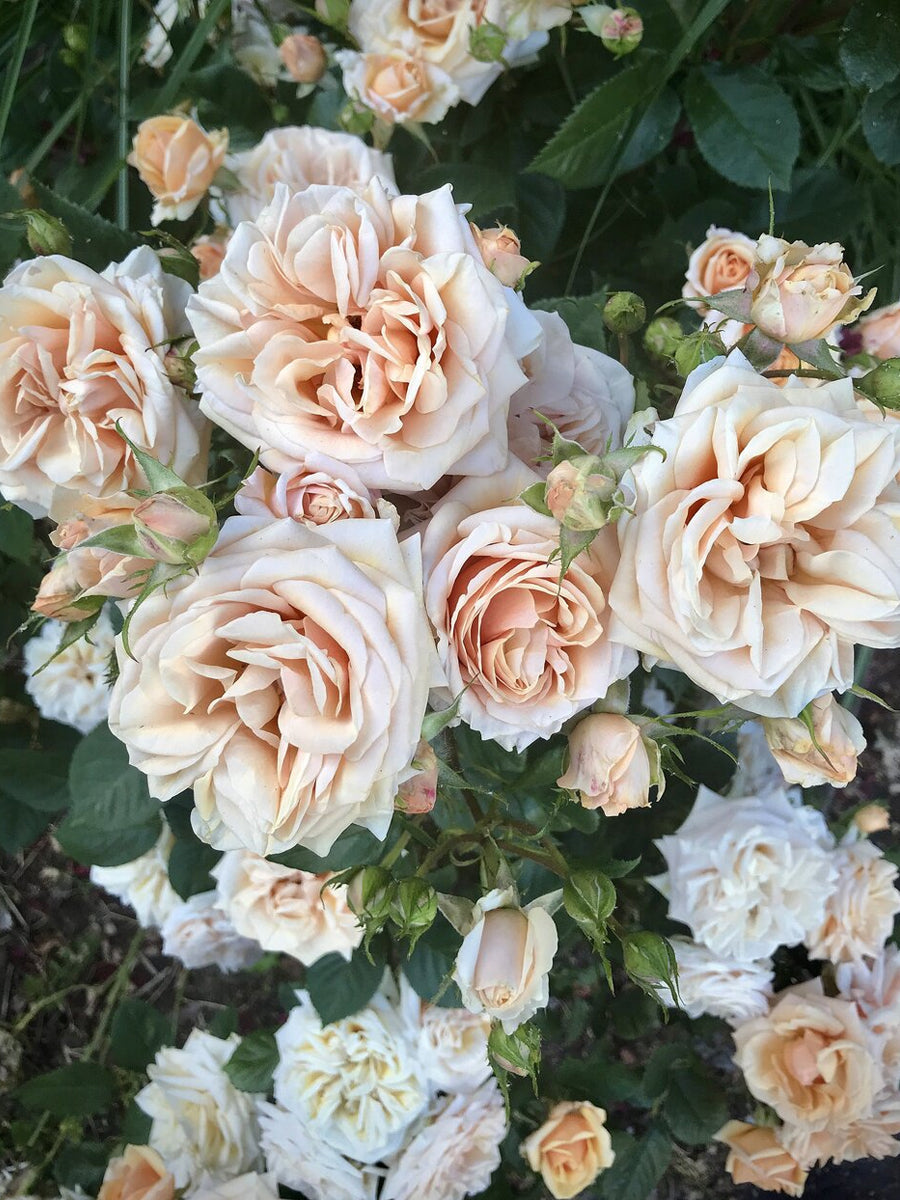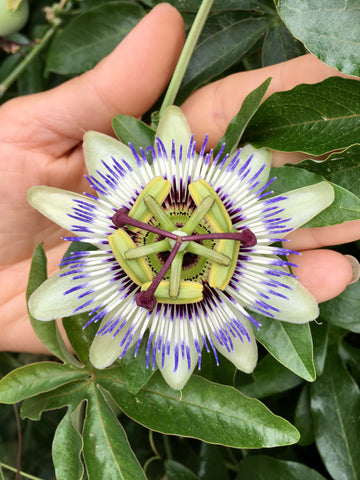
Welcome to the sensual side of plant life.
The word aphrodisiac comes from the Greek goddess Aphrodite, goddess of love, passion, fertility, beauty, and sexual pleasure. Our natural world shares these gifts from root to leaf, flower to seed, from avocado trees to passionflower, let’s discover the sexy side of plant life!
FLOWERS

Roses Greek myth tells the story of Aphrodite, her tale of heartbreak and of roses. When the goddess discovers her fallen lover, Adonis, she’s overcome with grief and her tears of sorrow fall onto white rose bushes, turning the petals to blood red.
Oh but those velvety layers of fragrant petals, despite their tale of tragedy, it is hardly a wonder they've symbolized love throughout the ages.
Rose petals hold medicinal benefits too. Known to stimulate circulation and clear away toxins while boosting metabolism, just a few reasons we infuse them into our Sacred Sip Tea.
Many enjoy the benefit of inhaling essential rose oil for an anti-anxiety remedy that promotes relaxation. Rose water flavors Turkish, Greek, Indian and French culinary dishes, and adds a floral note to craft cocktails and rose water has a calming effect when splashed on the skin.
But what's the actual science connecting of roses with love? Scent! Turns out that sweet, soft, musky undertone we inhale when we stop to smell the roses is a chemical compound called indole.
What is indole? It’s a scent, and a dirty one at that!
Indole is a musty, composting, fecal odor occurring throughout our natural world, an underlying note often employed to bring about a seductive edge to perfume. Indole has animalistic properties enticing your primal senses, reminiscent of how pheromones work, arousing curiosity and primitive intrigue.
Flowers high in indole compound include jasmine, gardenia, tuberose, neroli and orange blossom.
Crocus, the most well know is the Saffron Crocus aka Crocus Sativus with its radiant red stigma and delicate, deep lavender bloom. For over 4,000 years humans have treasured this autumnal bloom, celebrating both its medicinal and culinary properties. An ancient depiction of crocus sativus discovered in Iraq dates back to 2000 BC and Ancient Greeks were known to utilize crocus to boost their amorous spirits prizing the flower for sexual enhancing properties.
Today saffron threads lend their flavors to culinary dishes throughout the world and many cultures continue to count on saffron to increase sexual performance and libido. A culinary experience for all the senses! 
photo credit Getty Images
Each delicate stigma (known as a saffron thread), is carefully harvested by hand, a delicate and time consuming making it the most expensive and coveted spice in the world! *note that Crocus Sativus should not be confused with ANY OTHER Crocus, like the common Meadow Crocus, or Crocus Vernus (pictured below), both of which bloom in early spring and both of which are toxic. Only one type of Autumn Crocus is edible, Crocus Sativus!

Meadow Crocus
Jasmine flowers with their heady fragrance is perhaps best known for its aromatherapeutic properties. In ancient Egypt the flower was used to treat headaches. Jasmine was traded along the ancient Silk Road and became a holy flower in Buddhism. It also is the national flower of Pakistan.
So when we learned this natural mood booster is also a known aphrodisiac, we weren’t surprised to discover it contains high levels of indole! Like cacao and roses, the scent of jasmine releases serotonin in the brain, the happy chemical responsible for boosting your mood, increasing your sense of well-being and energy, all of which tend to lead to more frequent moments of amorous activities!
Passionflower, another favorite bloom with those vibrant, intoxicating colors, layer upon layer of texture from petal to ovary to stigma, anther, the visual anatomy make me swoon! Although its namesake points towards amorous properties, Passiflora’s medicinal properties promote relaxation and aid in comforting menstruation and recent studies point to alleviated libido in post menopausal women.
We consider Passiflora a comforting plant and encourage you to brew your lover a steamy mug of passionflower tea to celebrate its benefits.

Passionflower’s bloom from summer to early winter here in the Pacific Northwest
TREES
Avocado tree was named ‘Ahuacuatl’ by the Aztecs, roughly translated to ‘testicle tree’ (we’ll never going to look at an avocado tree the same). In fact, the Aztecs believed in the sexual power of the avocado so much that they forbid virginal women to leave the house while harvesting avocados! Avocados are rich in vitamin E, known to increase the intensity of an orgasm.
Cacao trees supply the world with beans that make chocolate. Yup, that heart shaped box of chocolates is by no means a coincidence. Italian author and notorious lover, Casanova, mentions drinking unsweetened chocolate throughout his memoirs boasting its unique power to sustain his sexual escapades. Cacao contains phenethylamine, a chemical stimulant that helps release serotonin, the same chemical released when falling in love. And the same one released when you dig your hands into that garden or houseplant soil! (Be sure to check out our blog post here)
The cacao bean also contains tryptophan which aids in producing serotonin, a chemical responsible for sexual arousal and elevated mood.
Moringa trees produce leaves considered a superfood beneficial to overall sexual health. The leaves are shown to enhance sexual performance and are a natural aphrodisiac for both men and women.

ROOTS
Maca Root was first discovered by Ancient Andean shepherds who ate the fleshy, starchy roots (think turnip) of this Peruvian ground cover and began feeding it to their livestock. They noticed an increase in overall health & fertility of their herds and, centuries later, science has proven Maca root is indeed a sexual stimulant responsible for increasing fertility in livestock and more recently, in humans as well. Maca root increases sexual desire and sexual pleasure, not to mention boosting overall health and energy as it contains a wealth of essential vitamins, minerals and fiber.
Ginseng root, native to North America and China, contains ginsenosides which are steroid-like compounds that stimulate libido (especially in men) and improve sexual arousal. Studies have shown it may also improve sexual arousal for menopausal women.

Fenugreek
LEAVES & SEEDS
Arugula, also known as Rocket, produce delicious leaves ancient Greeks philosophers claimed to increase libido. And for you’d reason! Arugula leaves contain trace minerals & antioxidants that inhibit libido reducing contaminants from entering into our system. They also promote circulation, increasing blood flow to all the nether regions!
Fenugreek leaves & seeds contain phytoestrogens known to boost sex hormones estrogen & testosterone in women and men. Dating back to 1500 BC in the Eastern Mediterranean region, fenugreek now grows around the world. In Egypt fenugreek seeds are boiled for tea, in Turkey the seeds are mixed with cumin & black pepper for pastırma, Indian dishes incorporate both fresh leaves and seeds into a variety of dishes with perhaps the most well known, curry. Delicious and arousing, yes please!
Did you know fenugreek is a key ingredient in our Sacred Plant Care Tonics and in our Herbal Chai Tea?
Damiana is claimed to be a natural female aphrodisiac & relaxant. Aztecs and Mayans used the leaves of the beautiful, yellow flowering shrub to increase circulation and sensitivity to female organs. Always use your best judgement and caution when consuming anything new, even if it’s natural!
Sending love to each and every one of you. Be well friends and thank you for being a part of the Sacred Elements community!
Karina and Team SE


